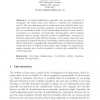Free Online Productivity Tools
i2Speak
i2Symbol
i2OCR
iTex2Img
iWeb2Print
iWeb2Shot
i2Type
iPdf2Split
iPdf2Merge
i2Bopomofo
i2Arabic
i2Style
i2Image
i2PDF
iLatex2Rtf
Sci2ools
EUROGP
2009
Springer
2009
Springer
One-Class Genetic Programming
One-class classification naturally only provides one-class of exemplars, the target class, from which to construct the classification model. The one-class approach is constructed from artificial data combined with the known in-class exemplars. A multi-objective fitness function in combination with a local membership function is then used to encourage a co-operative coevolutionary decomposition of the original problem under a novelty detection model of classification. Learners are therefore associated with different subsets of the target class data and encouraged to tradeoff detection versus false positive performance; where this is equivalent to assessing the misclassification of artificial exemplars versus detection of subsets of the target class. Finally, the architecture makes extensive use of active learning to reinforce the scalability of the overall approach.
Artificial Intelligence | EUROGP 2009 | Exemplars Versus Detection | In-class Exemplars | Target Class |
| Added | 26 May 2010 |
| Updated | 26 May 2010 |
| Type | Conference |
| Year | 2009 |
| Where | EUROGP |
| Authors | Robert Curry, Malcolm I. Heywood |
Comments (0)

